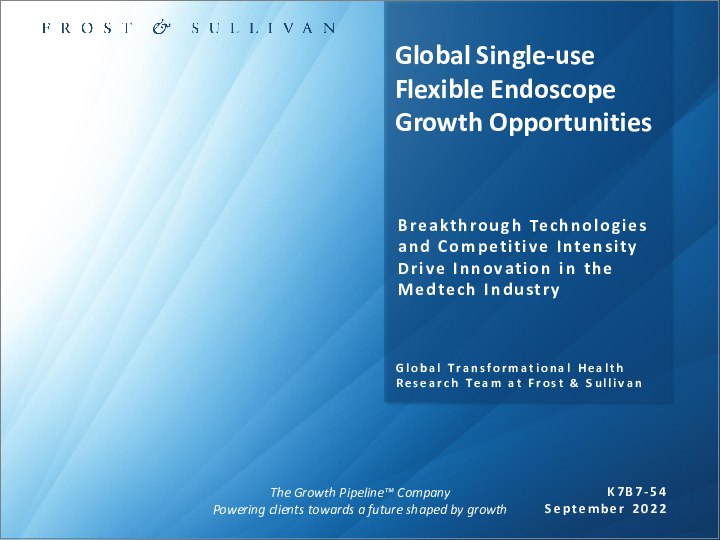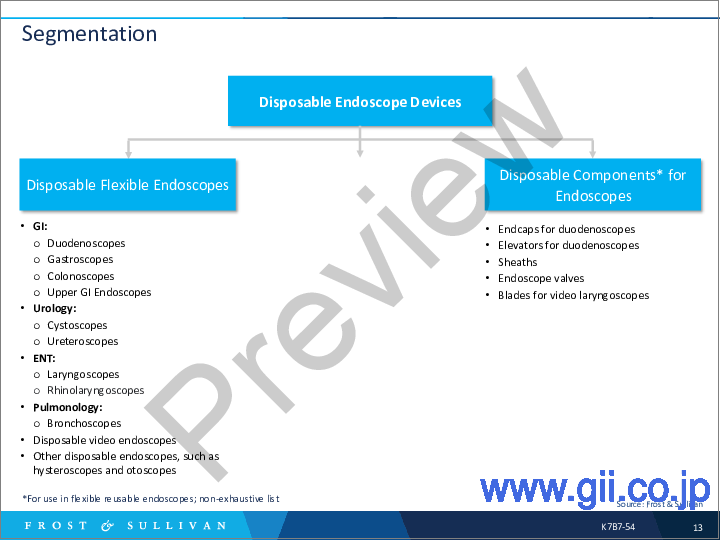|
|
市場調査レポート
商品コード
1130026
世界の単回使用フレキシブル内視鏡の成長機会Global Single-use Flexible Endoscope Growth Opportunities |
||||||
| 世界の単回使用フレキシブル内視鏡の成長機会 |
|
出版日: 2022年09月01日
発行: Frost & Sullivan
ページ情報: 英文 52 Pages
納期: 即日から翌営業日
|
- 全表示
- 概要
- 目次
画期的な技術と競争激化が医療技術業界のイノベーションを促進しています。また、単回使用内視鏡は、患者間の二次汚染リスクを排除するために、世界の内視鏡検査分野に革命を起こしている画期的な技術です。十二指腸鏡、気管支鏡、膀胱鏡などの再使用可能な内視鏡の感染リスクは高く、単回使用内視鏡への移行が進んでいます。
当レポートでは、世界の単回使用フレキシブル内視鏡市場を調査しており、促進要因と抑制要因、成長機会、戦略的考察などの包括的な情報を提供しています。
目次
戦略的必須事項
- 成長がますます困難になっている理由
- The Strategic Imperative 8(TM)
- 世界の単回使用フレキシブル内視鏡業界に対する上位3つの戦略的必須事項の影響
- 成長パイプラインエンジン(TM)を促進する成長機会
成長機会分析
- 分析範囲
- セグメンテーション
- セグメンテーション:用途タイプ別
- 成長促進要因
- 成長抑制要因
単回使用内視鏡へのシフト
- 単回使用十二指腸鏡への移行を加速する再使用可能な内視鏡の二次汚染リスク
- 内視鏡関連の有害事象の大半は再使用可能な気管支鏡と十二指腸鏡であると判明
- 複雑なデバイス設計による感染リスクで、2020年に再使用可能な内視鏡製品のリコールが増加
単回使用内視鏡と再使用可能な内視鏡 - 比較分析
- 世界の単回使用および再使用可能な内視鏡業界のシナリオ分析
- ECTR手術において、単回使用内視鏡は再使用可能な内視鏡よりも少なくとも10%費用対効果が高いことを証明する比較コスト分析
- 最大のERCP処置を実行するセンターにとって費用対効果が高いことを証明する再使用可能な十二指腸鏡
- 単回使用内視鏡は病院が大量購入することで費用対効果が高いことを証明
- 再使用可能なNPLよりも費用対効果が高いことが証明されているAmbuの単回使用鼻腔内視鏡
- 内視鏡医は、実績を向上させるために再使用可能な喉頭鏡よりもAmbuの単回使用鼻腔内視鏡を選好
- 単回使用内視鏡の利点
単回使用内視鏡の分析:メーカー別・タイプ別
- 単回使用内視鏡をカテゴリ別に提供している企業一覧
- 内視鏡用の単回使用パーツを提供している企業一覧
- 単回使用内視鏡をポートフォリオに含めることで汚染問題に対処する主要な内視鏡OEM
- 技術の採用を後押しする単回使用十二指腸鏡を使用した内視鏡手術に対するCMSのNTAP(新技術に加算償還が適用される制度)承認
- 内視鏡タイプ別の再使用可能内視鏡から単回使用内視鏡への潜在的な移行分析
- 再使用可能な内視鏡に単回使用アクセサリを追加し、患者の安全を確保
- 単回使用内視鏡の採用と世界のカーボンフットプリントへの影響
成長機会ユニバース
- 成長機会1:医療廃棄物削減のサステナビリティ目標
- 成長機会2:内視鏡手術が盛んなヘルスケア施設
- 成長機会3:すべての内視鏡処置に対する単回使用内視鏡の可用性
付録
- 再使用可能な内視鏡と単回使用内視鏡のコスト分析の定義:ECTRプロシージャの定義
- 再使用可能な内視鏡と単回使用内視鏡のコスト分析の計算:ECTRプロシージャの計算
- 調査分析の詳細
- 展示品一覧
- 免責事項
Breakthrough Technologies and Competitive Intensity Drive Innovation in the Medtech Industry
The single-use endoscope is a breakthrough technology that is revolutionizing the global endoscopy space to eliminate the risk of cross-contamination among patients. Despite compliance with manufacturers' instructions, multiple outbreaks from contaminated reusable endoscopes (specifically, duodenoscopes and bronchoscopes) continue to occur. Complex device design makes the foolproof reprocessing of devices difficult, attracting superbugs and leading to infection risks. The increased risk of infection associated with reusable endoscopes, especially duodenoscopes, bronchoscopes, and cystoscopes, is boosting the transition to disposable scopes. For instance, in the United States, the latest adverse event reports related to infection from contaminated scopes prompted the US FDA to recommend making endoscopes fully disposable or opting for endoscope design modifications. Government recommendations and preventive efforts, policies, and reimbursement programs have successfully powered innovation for efficient new technologies in the endoscopy market as single-use endoscopes are being increasingly recommended, specifically, duodenoscopes and bronchoscopes.
Moreover, the massive surgical backlog created by COVID-19 restrictions fuels the shift to single-use endoscopes as no setup time is associated with this technology, thereby driving workflow improvements; furthermore, faster room turnover can be achieved. Hence, not only is OR time and cost curtailed but the technology also enables an increased number of endoscopic procedures daily. As surgeries are the major revenue earners for hospitals, the use of single-use endoscopes promises increased return on investment (RoI).
To reduce infection risks in reusable endoscopes, endoscope original equipment manufacturers (OEMs) are making certain parts disposable, such as distal endcaps and elevator shafts. As these parts are difficult to clean during reprocessing, disposable parts are used to prevent infection.
However, cost and sustainability are the major restraints hindering the increased adoption of these disposable scopes. This Frost & Sullivan research service analyzes these factors in detail and provides an all-encompassing market analysis of single-use endoscopes.
Table of Contents
Strategic Imperatives
- Why Is It Increasingly Difficult to Grow?
- The Strategic Imperative 8™
- The Impact of the Top 3 Strategic Imperatives on the Global Single-use Flexible Endoscopes Industry
- Growth Opportunities Fuel the Growth Pipeline Engine™
Growth Opportunity Analysis
- Scope of Analysis
- Segmentation
- Segmentation by Application Type
- Growth Drivers
- Growth Restraints
Shift to Single-use Endoscopes
- Cross-contamination Risks in Reusable Endoscopes Accelerating the Transition to Single-use Duodenoscopes
- Reusable Bronchoscopes and Duodenoscopes Accounting for Most Endoscope-related Adverse Events
- Increased Reusable Endoscopic Product Recalls* in 2020 due to Infection Risks from Complex Device Design
Single-use versus Reusable Endoscopes-A Comparative Analysis
- Scenario Analysis of the Global Single-use and Reusable Endoscopy Industry
- Comparative Cost Analysis Proving that Disposable Endoscopes are at Least 10% More Cost-effective than Reusables in ECTR Procedures
- Reusable Duodenoscopes Proving Cost-effective for Centers Performing Maximum ERCP Procedures
- Single-use Endoscopes Proving Cost-effective when Hospitals Purchase in Bulk
- Ambu Disposable Rhinolaryngo Endoscopes are Proving to be More Cost-effective than Reusable NPLs
- Endoscopists Preferring Single-use Ambu Rhinolaryngo over Reusable Laryngoscopes for Enhanced Performance
- Advantages of Single-use Endoscopes
Single-use Endoscope Analysis by Manufacturer and Type
- List of Companies Offering Disposable Endoscopes across Categories
- List of Companies Offering Disposable Endoscopes across Categories (continued)
- List of Companies Offering Disposable Endoscopes across Categories (continued)
- List of Companies Offering Disposable Parts for Endoscopes
- Leading Endoscope OEMs Addressing Contamination Issues by Including Single-use Endoscopes in Portfolios
- CMS' New Technology Add-on Payment (NTAP) Approval for Endoscopic Procedures Using Disposable Duodenoscopes to Boost Technology Adoption
- Potential Transition Analysis of Reusable to Single-use Endoscopes by Endoscope Types
- Adding Disposable Accessories in Reusable Endoscopes and Ensuring Patient Safety
- Single-use Endoscope Adoption and its Impact on the Global Carbon Footprint
Growth Opportunity Universe
- Growth Opportunity 1: Sustainability Goal of Reducing Medical Waste
- Growth Opportunity 1: Sustainability Goal of Reducing Medical Waste (continued)
- Growth Opportunity 2: Healthcare Facilities with a High Volume of Endoscopic Procedures
- Growth Opportunity 2: Healthcare Facilities with a High Volume of Endoscopic Procedures (continued)
- Growth Opportunity 3: Disposable Endoscope Availability for All Endoscopy Procedures
- Growth Opportunity 3: Disposable Endoscope Availability for All Endoscopy Procedures (continued)
Appendix
- Sources for Cost Analysis of Reusable versus Disposable Endoscopes: ECTR Procedure Sources
- Sources for Cost Analysis of Reusable versus Disposable Endoscopes: ECTR Procedure (continued)
- Calculations for Cost Analysis of Reusable versus Disposable Endoscopes: ECTR Procedure Calculations
- Survey Analysis Details
- List of Exhibits
- Legal Disclaimer




